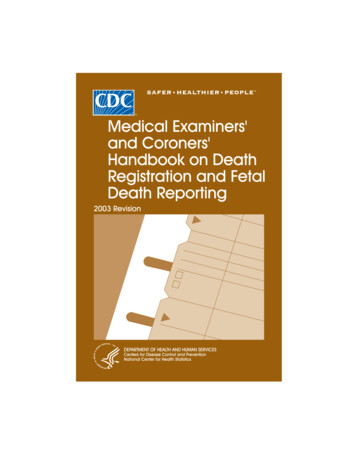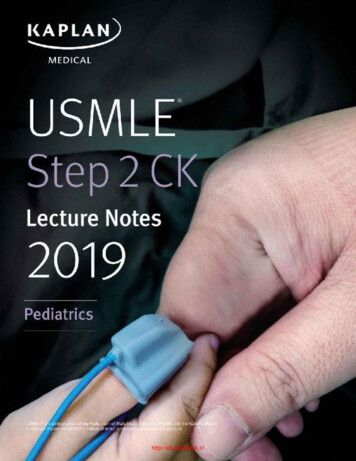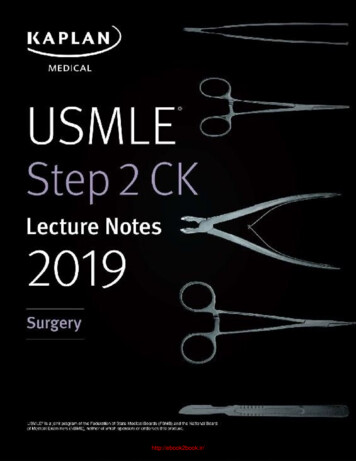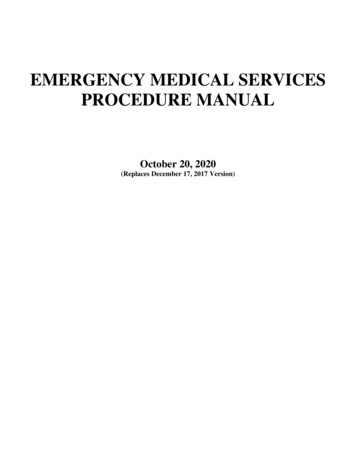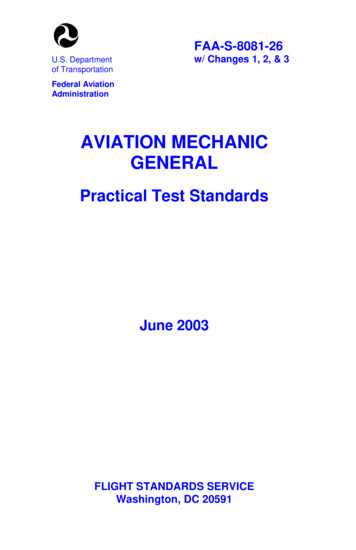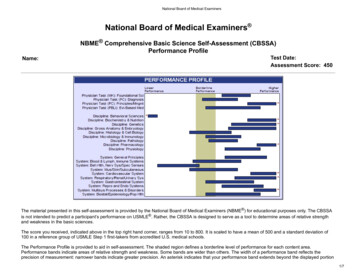
Transcription
National Board of Medical ExaminersNational Board of Medical Examiners NBME Comprehensive Basic Science Self-Assessment (CBSSA)Performance ProfileName:Test Date:Assessment Score: 450The material presented in this self-assessment is provided by the National Board of Medical Examiners (NBME ) for educational purposes only. The CBSSAis not intended to predict a participant’s performance on USMLE . Rather, the CBSSA is designed to serve as a tool to determine areas of relative strengthand weakness in the basic sciences.The score you received, indicated above in the top right hand corner, ranges from 10 to 800. It is scaled to have a mean of 500 and a standard deviation of100 in a reference group of USMLE Step 1 first-takers from accredited U.S. medical schools.The Performance Profile is provided to aid in self-assessment. The shaded region defines a borderline level of performance for each content area.Performance bands indicate areas of relative strength and weakness. Some bands are wider than others. The width of a performance band reflects theprecision of measurement: narrower bands indicate greater precision. An asterisk indicates that your performance band extends beyond the displayed portion1/7
National Board of Medical Examinersof the scale. Small differences in the location of bands should not be over-interpreted. If two bands overlap, performance in the associated areas should beinterpreted as similar. Because CBSSA is designed to be integrative, many items contribute to more than one content area. Thus, caution should be usedwhen interpreting differences in performance across content areas. While not all content areas are included in every form, overall content coverage iscomparable in the various forms of CBSSA.Additional information concerning the topics covered in each content area can be found in the USMLE Step 1 Content Description and Sample Test Materials(www.usmle.org).2/7
National Board of Medical ExaminersNational Board of Medical Examiners NBME Score Interpretation GuideComprehensive Basic Science Self-Assessment (CBSSA)This guide will help you interpret the Assessment Score you received on your CBSSA Performance Profile.How to read your scores:In the table on page 3 locate your CBSSA score and find the approximate corresponding USMLE Step 1 score in the adjacent column. For example,if your CBSSA score is 390, it approximates a Step 1 three-digit score of 205.CBSSA scores are scaled to have a mean of 500 and a standard deviation of 100. USMLE Step 1 scores are reported on a three-digit scale with amean ranging from 228 to 229 and a standard deviation of approximately 20. Both means are based on the performance of USMLE Step 1 first-timeexaminees from accredited US medical schools.What you should know:The approximate corresponding USMLE Step 1 score is based on your performance on CBSSA and is not an exact prediction of what you will score onyour USMLE exam.Your actual USMLE Step 1 score is likely to fall within the range provided next. This range represents domestic and international students whotake the self-assessment one week prior to the USMLE.The graph that follows shows the distribution of the difference between actual USMLE Step 1 scores and approximate Step 1 scores for those takingthe CBSSA (Step 1 score minus CBSSA score). Each bar represents the percentage of students with a given difference between their actual Step 1score and their anticipated Step 1 score based on the CBSSA. Positive differences mean that the students scored higher on Step 1 than on CBSSAand negative differences mean that the students scored higher on CBSSA than on Step 1.3/7
National Board of Medical ExaminersHow to estimate future USMLE test performance:Two-thirds of the time your USMLE Step 1 score will fall within 13 points of the approximate corresponding Step 1 score shown below. You can calculate yourrange by adding 13 points to your Approximate Step 1 Three-Digit score shown and also subtracting 13 points from your Approximate Step 1 Three-Digitscore. For example, if your approximate Step 1 score based on CBSSA is 220, we anticipate that your actual Step 1 score will fall between 207 and 233 twothirds of the time. This range is based on students who took CBSSA within one week before taking Step 1.Your self-assessment exam is intended to indicate your readiness to take the USMLE and/or to help you become more familiar with its content.The CBSSA is designed to serve as a tool to determine areas of relative strength and weaknesses in the basic sciences.Please keep in mind additional factors that occur between the date of this result and your actual USMLE exam could shift your score up or down versusyour NBME self-assessment score.Multiple exams:If you’ve taken multiple self-assessment exams to prepare for the USMLE, there are several things to remember:If you have taken multiple CBSSAs shortly before you are scheduled to take USMLE Step 1, your average score across the tests may provide the mostaccurate measure of your performance. You should use this average score to calculate your estimated Step 1 score range. NBME self-assessmentsvary in difficulty and most are generally easier than the USMLE Step 1 exams. Therefore, the number of questions that you need to answer correctlyvaries according to the total level of difficulty of the exam.For this reason, the number of incorrect answers cannot be compared to your number incorrect on a different NBME self-assessment.You also cannot use the number of incorrect answers on the self-assessment to predict your performance on USMLE Step 1.4/7
National Board of Medical ExaminersThe self-assessment score that is provided on this report does adjust for differences in difficulty and can be compared across exams and used toestimate your approximate USMLE Step 1 score.Remember that this approximate corresponding USMLE score is based on what you knew in that moment. Different testing conditions (including thehigh-stakes nature of Step 1) as well as additional learning or forgetting are likely to affect future test results.NBME does not guarantee that any individual performance on NBME self-assessments will predict performance on any USMLE exam. We cautionparticipants against making any predictive inferences.On the Performance Profile: MK—Medical Knowledge; PC—Patient Care; PBLI—Practice-based Learning and Improvement.5/7
National Board of Medical ExaminersCBSSA 0480470460450ApproximateStep 1Three-Digit 5223221219217CBSSA 80706050ApproximateStep 1Three-Digit 21401381361346/7
National Board of Medical Examiners44043042041021521321120940302010132130128 128The material presented on the NBME self-assessments is owned and copyrighted by the National Board of Medical Examiners and provided for educationalpurposes only. Participants may not transfer or reproduce self-assessment materials in any way without permission from the NBME. Any unauthorized transferor reproduction of these materials, by any means, including but not limited to, storage in a retrieval system, transmission, printing, memorization, ordistribution is strictly prohibited.June 20187/7
National Board of Medical ExaminersNational Board of Medical Examiners NBME Comprehensive Basic Science Self-Assessment (CBSSA)Name:Test Date:Performance ProfileClick on the category below to view your correctly and incorrectly answered questions.Detailed Analysis by ContentPhysician Task (MK): Applying Foundational Science ConceptsPhysician Task (PC): DiagnosisPhysician Task (PC): Principles of ManagementPhysician Task (PBLI): Evidence-based MedicineDiscipline: Behavioral SciencesDiscipline: Biochemistry & NutritionDiscipline: GeneticsDiscipline: Gross Anatomy & EmbryologyDiscipline: Histology & Cell BiologyDiscipline: Microbiology & ImmunologyDiscipline: PathologyDiscipline: PharmacologyDiscipline: PhysiologySystem: General Principles1/2
National Board of Medical ExaminersSystem: Blood & Lymphoreticular and Immune SystemsSystem: Behavioral Health & Nervous Systems/Special SensesSystem: Musculoskeletal, Skin, & Subcutaneous TissueSystem: Cardiovascular SystemSystem: Respiratory and Renal/Urinary SystemsSystem: Gastrointestinal SystemSystem: Reproductive and Endocrine SystemsSystem: Multisystem Processes & DisordersSystem: Biostatistics & Epidemiology/Population Health*Because CBSSA is designed to be integrative, many items contribute to more than one score category.2/2
National Board of Medical ExaminersNational Board of Medical Examiners NBME Comprehensive Basic Science Self-Assessment (CBSSA)Longitudinal Performance ProfileHistory of Performance Across Multiple Completed TestsName:Report Date:TakeTest DateTimingAssessment Score12/28/2018Standard40027/31/2018Standard450The material presented in this report is provided by the National Board of Medical Examiners (NBME ) for educational purposes only. The CBSSA is notintended to predict a participant’s performance on USMLE. The CBSSA is designed to serve as a tool to determine areas of relative strength and weakness inthe basic sciences. This report provides a history of your performance on the last six assessments you have completed, along with test date and timinginformation. The test date corresponds to the date you completed each assessment. The Assessment Score that you received on each completed test asindicated in the table above, ranges from 10 to 800. It is scaled to have a mean of 500 and a standard deviation of 100 in a reference group of USMLE Step 1first-takers from accredited U.S. medical schools. A score interpretation guide has been included at the end of this report to help you interpret yourAssessment Scores.The graphical performance profiles are provided to aid in self-assessment and are a compilation of profiles for up to the six most recently completedassessments started on or after November 21, 2016*. The performance profile graphs provide an indicator of your performance across multiple completedassessments for each content area. The shaded region defines a borderline level of performance for each content area. Performance bands indicate areas ofrelative strength and weakness. Some bands are wider than others. The width of a performance band reflects the precision of measurement: narrower bandsindicate greater precision. A row of asterisks indicate that your performance band extends beyond the displayed portion of the scale. Small differences in thelocation of bands should not be over-interpreted. If two bands overlap, performance should be interpreted as similar. Because the CBSSA is designed to beintegrative, many items contribute to more than one content area. Thus, caution should be used when interpreting differences in performance across contentareas. While not all content areas are included in every form, overall content coverage is comparable in the various forms of CBSSA.Additional information concerning the topics covered in each content area can be found in the Step 1 Content Description and Sample Test Materials(www.usmle.org).*CBSSA exams started on or after November 21, 2016 cannot be longitudinally compared against those started before November 21, 2016.1/10
National Board of Medical ExaminersNational Board of Medical Examiners NBME Comprehensive Basic Science Self-Assessment (CBSSA)Longitudinal Performance ProfileHistory of Performance Profiles Across Multiple Completed TestsName:Report Date:Performance Profile BandsLLower PerformanceB (shaded area)Borderline PerformanceHHigher Performance2/10
National Board of Medical Examiners3/10
National Board of Medical Examiners4/10
National Board of Medical Examiners5/10
USMLE Step 1 scores are reported on a three-digit scale with a mean ranging from 228 to 229 and a standard deviation of approximately 20. Both means are based on the performance of USMLE Step 1 first-time . vary in difficulty and most are generally easier than the USMLE Step 1 exams. Therefore, the number


